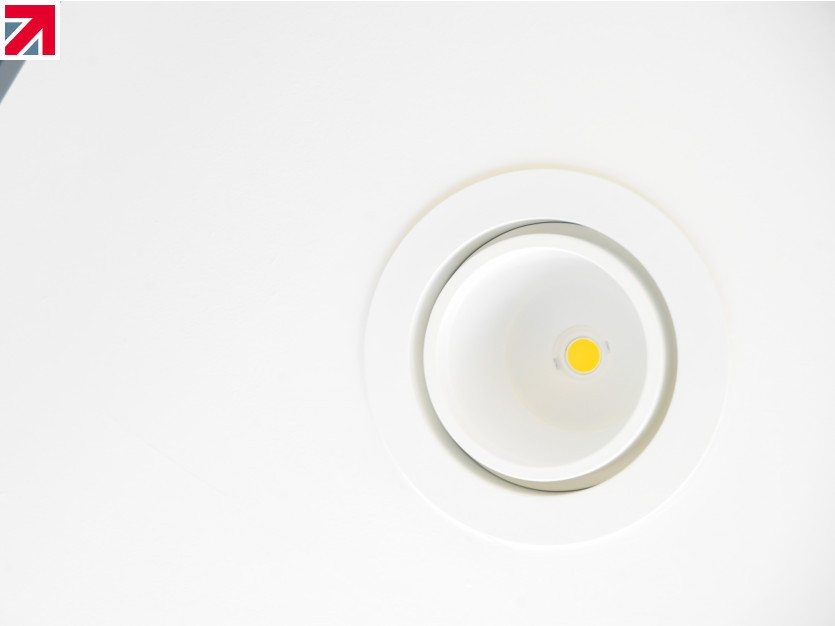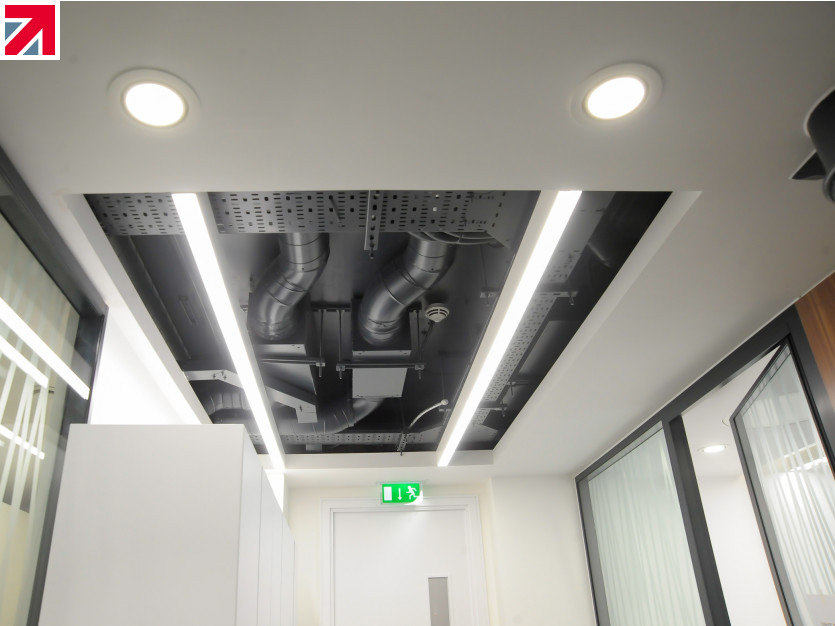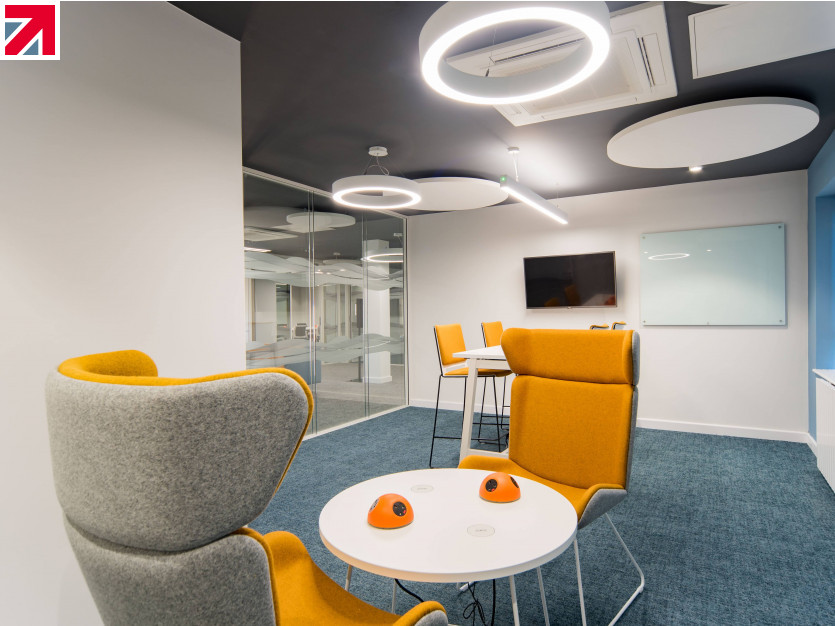Emergency lighting is a fundamental part of any fire safety strategy in commercial buildings and offices. In this guide, our team have outlined some of the key pieces of information and facts about emergency lighting to support electrical contractors, responsible persons, developers and business managers alike.
WHY IS EMERGENCY LIGHTING IMPORTANT?
In an emergency, building occupants need to be able to evacuate quickly and safely. Main lighting sources often fail during a fire and buildings can become more difficult to navigate if smoke is present. Darkness and smoke reduce visibility, increase the physical threat to welfare and heighten the chance of panic.
Emergency lighting automatically comes on when the power to the normal lighting fails, illuminating escape routes and fire safety equipment.
KEY INFORMATION ABOUT EMERGENCY LIGHTING REGULATIONS
Emergency lighting is installed in most new buildings during the construction stage or during category A fit-outs. Emergency lighting products are usually specified by the contractor in relation to current building regulations and the results of a fire risk assessment.
Fire risk assessments are a legal requirement for all non-domestic premises in line with fire safety regulations stated in the Regulatory Reform (Fire Safety) Order 2005. The Order stipulates that emergency lighting that clearly illuminates escape and evacuation routes during a fire must be present.
The Building Regulations 2006 (Approved Document B) also contains general requirements for fire safety in commercial buildings, including the provision of emergency lighting as part of a large fire safety infrastructure.
The Construction Products Regulation (305/2011/EU) includes instructions for products to ensure that they meet safety requirements. To meet this regulation, emergency lighting must comply with BS 5266-1.
BS 5266-1 is the code of practice for the emergency lighting of premises. This standard offers guidance on the layout of emergency lighting in a commercial building and provides a minimum illuminance of 1 lux over the floor area that people may need to cross (higher levels may be needed if indicated in a risk assessment).
The Regulatory Reform Order, Approved Documents and BS 5266 cross-reference each other and are the main methods of achieving compliance. Failure to reach compliance and uphold statutory requirements could lead to drastic consequences on a legal and welfare level.
WHERE IS EMERGENCY LIGHTING REQUIRED?
Emergency lighting needs to provide illumination throughout escape routes. In fact, any area of a commercial building that is occupied needs emergency lighting. Emergency LED lighting should indicate changes in surface height (e.g. staircases and steps), fire and first-aid points, changes in direction and exit routes.
Therefore, emergency lighting will be indicated on most lighting designs in a range of rooms and corridors. Specification and plans will vary drastically based on the height and layout of a building e.g. a single-storey office will have very different requirements to a 16-storey building.
Lighting design plans are often made up of a mixture of types of emergency lighting to ensure all safety requirements are covered while upholding the functionality and appearance of a commercial environment.
READ ABOUT THE DIFFERENT TYPES OF EMERGENCY LIGHTING
GUIDANCE FOR EMERGENCY LIGHTING TYPES
The language around emergency lighting can seem confusing as everything often comes under one term. The BSI guide to emergency lighting explains that there are two main types of emergency lighting: emergency escape lighting and standby lighting.
Emergency escape lighting is defined in the guide as the “part of emergency lighting that is provided to enable safe exit in the event of failure of the normal supply”.
Standby lighting is “that part of the emergency lighting provided to enable normal activities to continue in the event of failure of the normal mains supply”.
There are also different modes of operation for emergency lighting luminaires: maintained and non-maintained.
Maintained emergency lights are powered by mains electricity and make up the normal room lighting system. However, maintained emergency lighting will stay lit in an emergency for a specific duration powered by a backup battery. Maintained LED lighting can include fire exit signs, bulkhead lighting and recessed downlights.
Non-maintained emergency lighting only activates for a specific time when the power fails. Non-maintained lighting is specific for workplaces that are usually lit when occupied. This mode of lighting is powered by a battery that is charged from the mains.
Choosing a mode of operation for emergency lighting often relies on individual circumstances outlined in a fire risk assessment.
THE FUTURE OF EMERGENCY LIGHTING IS LED
The advantages of LED lighting are already seen in architectural luminaires and commercial lighting across the board. Utilised LED lighting instead of alternative lighting options will help save businesses money, reduce energy output and get more return on investment and confidence.
HOW IS EMERGENCY LIGHTING MAINTAINED AND TESTED?
BS 5266-8 / BS EN 50172 dictate that responsible persons must test all emergency lighting systems monthly. The latest British Standard recommends that you have a 3-hour emergency lighting test once a year. During this test, the main light circuit should be switched off and emergency lights left on for a 3-hour period to find out of any batteries need replacing.
MOUNT LIGHTING: A TRUSTED SUPPLIER OF HIGH-QUALITY LED EMERGENCY LIGHTING
Mount Lighting supplies high-quality emergency LED lighting to suit many applications in commercial and industrial environments.
There are lots of optional extras available, including DALI monitored emergency functionality and presence detection. Mount Lighting has also developed a range of innovative smart wireless controls and emergency lighting kits that can be used to convert existing LED lamps with accommodating drivers.
From illuminated exit signs to self-contained escape route lighting, we have you covered. Contact the team for more information today on 01582 369 005 or email sales@mountlighting.co.uk
Find out more about Mount Lighting Ltd on their member profile page here
Member-created content 2 years ago | From members


